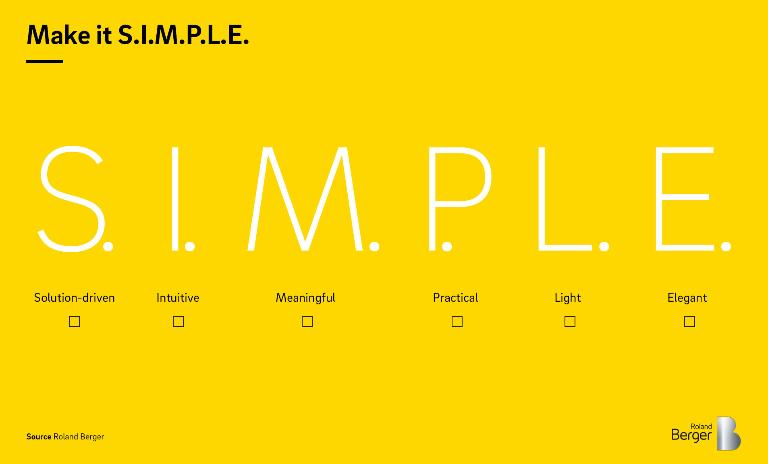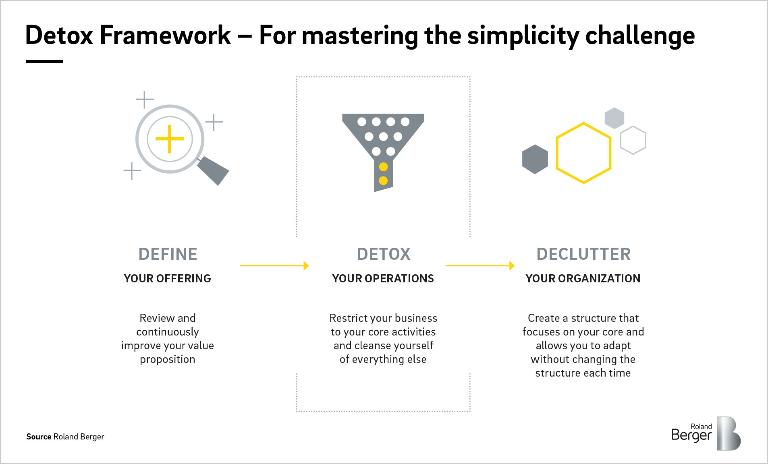

MAKE IT S.I.M.P.L.E.
A checklist inspired by science
Mention science to businesspeople and you’re likely to get a less than enthusiastic reaction. Isn’t science the realm of white-coated madmen with wild hair and bubbling test tubes, out of touch with real life and the world around them?
"For the simplicity that lies this side of complexity, I would not give a fig, but for the simplicity that lies on the other side of complexity, I would give my life."
Having worked many years as a theoretical and computational physicist, I can assure you that this is not the case. Science is all about the search for simple models, elegant solutions that explain complex matters, the ultimate quest for simplicity in a world that is anything but. Science helps us solve the puzzles that the world throws at us in a pioneering way. It advances understanding through the application of methods that are concrete, straightforward and have a proven track record.
But the scientific approach can be of fundamental value to business, too. With today’s challenges of digitalization, automation and robotization, the vast reams of data at our fingertips and breakthrough technologies of artificial intelligence and virtual reality snapping at our heels, the need for simplicity in business is greater than ever. Complexity is growing and our natural inclination is to match complex problems with complex solutions. Yet, if we want to remain relevant for stakeholders and continue delivering value, we must strive for precisely the opposite: clarity, transparency and – yes – simplicity.
In this article we suggest a checklist inspired by science, a tool for ensuring that your proposed business solution is driven by simplicity. We call this the S.I.M.P.L.E. checklist. Each letter of the acronym describes a key criterion that your solution must meet. Taken together, the six criteria describe a solution that is truly fit for purpose in today’s complex world.
In search of simplicity, beyond complexity
Simple isn’t easy
"Simplicity is the ultimate sophistication."
The S.I.M.P.L.E. checklist is effective, but meeting all six criteria isn’t easy. Simplicity goes against the natural tendency within organizations towards complexity – the “villains in the game”, such as the endowment effect and linear thinking, as we discussed in our recent Think:Act publication Detox your business: A hands-on approach to succeed in complex markets. Here are just some of challenges we often run up against:
- Lack of time and resources
This makes it difficult to tick off all the complex criteria with the right amount of detail - Ego
Sometimes egos get in the way. To take just one example, the more important people feel, the more status symbols they tend to gather. Those status symbols often take the form of unnecessary meetings, special administrative processes to arrange appointments or privileged office space. All of this adds to complexity, draining resources and deflecting attention from the real goal of simplicity - The endowment effect
Sometimes decisions are irrationally swayed. In behavioral economics, this is known as the endowment effect: the idea that once you own something you are willing to pay more for it than you would if you didn’t own it. A well-known experiment by Kahneman, Knetsch and Tahler divided a group of people into buyers and sellers of a coffee mug. It found that the people in the group given ownership of the mug placed a much higher value on it those who didn’t · - Linear thinking
This is the trap of thinking in a straight line, from one point to another. It can lead us to think that big problems require big solutions. Intuitive, but wrong! As the economist Schumacher put it in his 1973 essay Small is Beautiful: “Any intelligent fool can make things bigger, more complex, and more violent. It takes a touch of genius – and a lot of courage to move in the opposite direction.”
Finding the sweet spot
Faced with too much information, the decision-making network in the human brain fails to compute. Businesses have an opportunity here to help swamped consumers cut through clutter, by simplifying the choice. Amazon’s simple and effective solution is to both understand and anticipate their needs and meet those needs in an efficient and relevant way.
Keeping operating models simple is a quick way to achieving competitive edge. Citibank’s Citi Simplicity card promising “no late fees ever” is one example. In 2005, Ford’s “keep it simple” approach to lower supply drove higher demand and better pricing. Lexmark’s “uncomplicated” campaign made clear promises. The application of simplicity, and the timeless beauty that it engenders, has always been valued; from IKEA to Nike, from Expedia to Southwest Airlines there are plenty of past examples in business to prove it.
In essence, then, the more complexity that there is in the market, the more simplicity stands out. Generally speaking, simplification is about distillation. It’s about filtering all your ideas to extract only the meaningful. Finding the sweet spot – a solution that matches all six criteria on the S.I.M.P.L.E. checklist – is clearly not simple. It takes time and effort. But that’s not altogether a bad thing: Scientists like to dwell on things, and in business as in science, good things come to those who take the time to make them happen.







